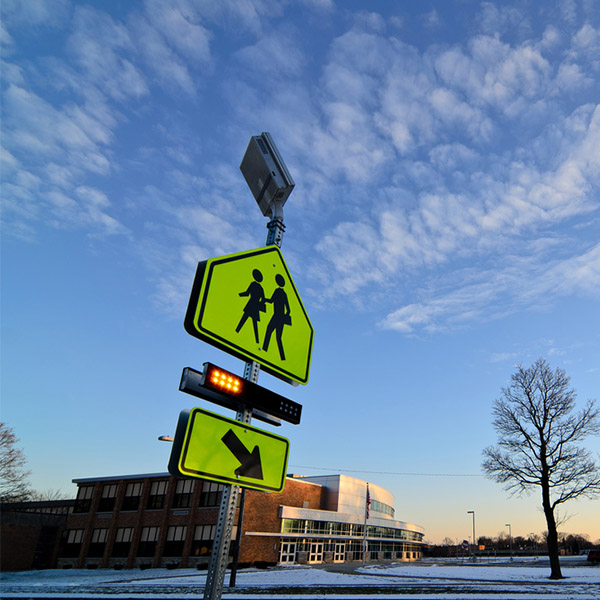Watch Part 2 of our school zone safety series
In 2017, there were nearly 6,000 pedestrian fatalities in traffic crashes. Over three-quarters of those fatalities occurred in non-intersection locations where speeds are faster, and driver yield rates are lower. Children age 14 and under account for more than 200 of these pedestrian fatalities and nearly half of them occur traveling to and from school. An FHWA study found that children between 5 and 14 years old traveling to school cross an average of three streets each way that don’t have intersections or signals. One way those children can be kept safer during their commute is by increasing driver awareness of crosswalks.
Here in Part 2 of our school zone safety series, we will turn our attention to crosswalk treatments—specifically the pairing of rectangular rapid flashing beacons—commonly known as RRFBs—with crosswalk signs. This video will focus on RRFB effectiveness, how the technology works to improve driver awareness, and how it can fit into a school zone safety plan.
Keep in mind this is a general guideline only: your state and/or local jurisdiction may have different requirements for crosswalk design and sign placement standards to meet their unique safety concerns.
Marked crosswalks can help decrease random crossings people make to get to their destination. The 2009 MUTCD advises that because non-intersection crossings are generally unexpected by road users, warning signs should be installed on all marked crosswalks at non-intersection locations. For school zone crossings, use an S1-1 school sign with a W16-7P diagonal downward arrow plaque. For mid-block, roundabouts, or other unsignalized intersection crossings, a W11-2 warning sign assembly is used. Depending on the roadway configuration, two or more warning signs should be used at each crossing.
You can download Carmanah’s RRFB Application guide to learn more about recommended crosswalk layouts.
School Zone Crosswalk Effectiveness
While signs and road markings do legally establish a crosswalk, they are in most cases not enough to make drivers yield to crossing pedestrians. Some busy roads may have driver yield rates as low as 0%.
While the MUTCD includes flashing circular crosswalk beacons as an additional treatment option to help draw drivers’ attention to pedestrians, a more effective treatment uses the newer RRFB option. The MUTCD has issued an interim approval, IA-21, for rectangular rapid flashing beacons, which is the focus of this video.
One of the most well-known studies on RRFBs, a 2010 FHWA-sponsored study conducted several experiments on 19 mid-block crosswalks in Florida, and a few from Washington, DC, and Illinois. Before installing RRFBs, one experiment showed an average combined driver yield rate of less than 1.7%. Once RRFBs were installed, the yield rate increased to an average of 79% after 7 days, 86% after 30 days, and 83% after 365 days. 2 years later, compliance held at 85%, showing not only an impressive change in the short term, but the long term, as well. Across a range of studies since, RRFBs have resulted in driver yield rates between 82% and 93%.
So, why does an RRFB work better than a circular beacon? Unlike most other traffic signals, RRFBs were designed to loosely mimic the visual effect of emergency vehicle lights like ambulances. RRFBs use higher intensity lights with a quick flash pattern, making them highly visible when competing with other traffic signals, headlight glare, or wet roads.
RRFBs can easily be added to existing school crosswalk sign poles or installed as part of a new crosswalk installation and can be powered by solar. The placement of the RRFB lightbar can vary, and again, depending on the roadway design, uni or bi-directional lightbars and signs may be required. (See RRFB Application Guide).
The minimum size of the rectangular-shaped yellow indications, each with an LED-array-based light source, must be 5 inches wide by 2 inches high at minimum. These must flash rapidly in a wig-wag plus simultaneous flash pattern, in sync with all other RRFBs at the crossing. The MUTCD advises that the downward arrow plaque be mounted below the pedestrian crossing sign at a minimum of 7 feet from the bottom of the sign to the sidewalk.
RRFBs are dark until pedestrian actuation. Pedestrians may activate the RRFB via passive detection, or via a push button. R10-25 signs should be installed to explain to users the purpose and use of the pedestrian push button. To meet ADA guidelines, the push button should be installed at a height of approximately 3.5 feet, and no higher than 4 feet.
The RRFB treatment is invaluable for increasing yield rates in unmarked midblock crosswalks near school zones—keeping children and other pedestrians safe.
Learn more
Check out the rest of this video series to learn about other possible school zone treatments.
